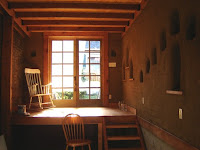When I was
developing the model that we now call member-driven church, I did a 2 year
study of what the Bible actually said about how to do church. The biggest
revelations came when I realized how much of what we do for church is
"extra-biblical". We added rules and habits the Bible doesn't
require.
A great example is
the pulpit.
The Bible calls us
to teach the word, to study the Bible, naming teachers and preachers as
spiritual gifts from God. And we've had sermons delivered from a pulpit for
centuries. So when we read the Bible today, it's easy to assume that it has
always been done this way. I once did.
But it's simply not
true. Our modern practice a weekly sermon delivered from a pulpit was added to
church life many centuries after the church began. The Bible calls us to teach,
yes, but not necessarily to use the sermon method of teaching every week. It's
merely one of many good options. (Think about the variety of ways Jesus
developed his disciples.)
And here's how the
pulpit became the centerpiece of the typical church. Here's the History of the
Pulpit. (Note: the pictures are illustrative, not the actual items. Those
weren't considered important enough to capture in images.)
1st-2nd Century - Adding a Chair To Communion
Sometime around a
hundred years after the cross, many churches put a chair behind the Communion
Table, and the leader would sit there and offer spiritually encouraging
thoughts before passing out the bread and wine. Then they shifted to a desk--a
chair with a flat surface to hold papers--to make it a more practical space for
him to read from documents during this time.
The most common
centerpiece of the service was Communion and the speaking was a bonus while
they passed out the elements.
3rd-5th Century - Raising the Desk (Birth of the
Stage)
By around 250 AD
they put the desk on a stage and by around 300 AD a few churches started
raising the desk platform higher so the leader could stand instead of sit. It
was the birth of the modern pulpit--but the big shift, sparking a new name,
wasn't about a place to put notes, but having leaders stand on a stage. (Pulpit
comes from Latin, "pulpitum", meaning stage.)
However, the
teachers didn't talk weekly and were still considered a support feature to
Communion.
6th Century-16th Century - Pulpit Becomes Standard
Architecture
Even then, it wasn't
until between 500-600 AD that it became
standard for churches to build a what we'd consider a true pulpit. And it
wasn't until then that sermons were a weekly occurrence. But these weekly
sermons were typically merely 3-5 min long. It was still an inspirational bonus
to the service, not the main event.
16th Century-21st Century - Sermons Supplant Communion
It wasn't until the
Great Reformation that sermons began lasting 25-45 min. It was also during this
time that the Reformers decided to make the sermon the centerpiece of the
Sunday service..
Today's Assumptions
It's often assumed that being called to
ministry means being called to preach.
Pastors today
protect the pulpit (who gets the speak behind it and what they say) as if it
was the cornerstone of their church. So letting someone speak from the pulpit
is considered something to be preciously guarded. I'm not arguing for careless preaching. I'm just saying it wasn't always that
big of a deal.
Our Approach
We don't have a
pulpit in our church. Before you nod and say, yeah, we don't either--I'm not
saying we use a simple music stand or even a super-hip iPad stand (I just saw
one for the first time--the medieval church goes 21st century). Remember the
original Latin root word was about the stage, not the note-holding stand.
Our members sit in
circles to study the word. If I need to introduce the Bible study, I like to
walking around the room as I talk. Often I'll get out a chair to sit down and
talk with them about the Bible (it's a true dialogue where I ask questions and
they even ask questions). I don't raise myself above them or restrict the
conversation to my thoughts only (lecture-style).
Final Reminder
Keep in mind, I'm
not opposed to a stage. The stage is my personal background and gift-mix. I've
seen many life impacted by stage-based ministry--mine included. Our music team
doesn't sit around a table when they play. We have the drums and keys and guitars
clustered at one end of the room. Stages have very practical purposes.
I don't want us to
mindlessly become anti-stage and reject that tool. I just don't want us to be
mindlessly stage-based and assume that teaching means stage-delivered lectures.
They're not wrong, per se. They're just not required by the Bible.
What would it look
like for you to take one step out of your assumptions? Maybe you could get down
from your stage and walk around this Sunday? Maybe you could get out a chair
and sit down on the floor level with everyone?






I was curious about the origin of the pulpit a while back and the best example I can find for it in the bible is in Nehemiah chapter 8 specifically mentioned in verse 4.
ReplyDeleteGreat reference. Thanks for sharing! The wooden podium Ezra uses in the passage is a great example. And while Jesus didn't use a podium per se, he often went up on a hillside--or one time stood in a boat--to help people see & hear him better.
DeleteIf you are going to speak a crowd, then it's a smart idea to find a way for everyone to see you.